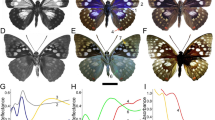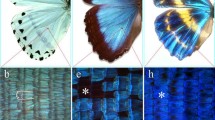Abstract
The ventral hindwings of Pipevine Swallowtail butterflies, Battus philenor, display a colourful pattern, created by variously coloured wing scales. Reflectance and transmittance measurements of single scales indicate that the cream and orange scales contain papiliochrome pigments, while brown, black and blue scales contain melanin. Microspectrophotometry and scatterometry of both sides of the wing scales show that the lower lamina acts as a thin film, with reflection properties dependent on the scale’s pigmentation. Notably in the orange scales, the reflectance spectrum of the lower lamina is tuned to the pigment’s absorbance spectrum. The dorsal hindwings of the male (but not the female) B. philenor are blue-green iridescent. At oblique illumination, the light reflected by the male’s dorsal hindwings can be highly polarised, which may have a function in intersexual signalling.








Similar content being viewed by others
References
Arikawa K (2003) Spectral organization of the eye of a butterfly, Papilio. J Comp Physiol A 189:791–800
Bálint Z, Kertész K, Piszter G, Vértesy Z, Biró LP (2012) The well-tuned blues: the role of structural colours as optical signals in the species recognition of a local butterfly fauna (Lepidoptera: Lycaenidae: Polyommatinae). J R Soc Interface 9:1745–1756
Bandai K, Arikawa K, Eguchi E (1992) Localization of spectral receptors in the ommatidium of butterfly compound eye determined by polarization sensitivity. J Comp Physiol A 171:289–297
Biró LP, Kertész K, Vertésy Z, Márk GI, Bálint Z, Lousse V, Vigneron JP (2007) Living photonic crystals: butterfly scales—nanostructure and optical properties. Mat Sci Eng C 27:941–946
Blest AD (1957) The function of eyespot patterns in the Lepidoptera. Behaviour 11:209–256
Brower JVZ (1958) Experimental studies of mimicry in some North American butterflies: part II. Battus philenor and Papilio troilus, P. polyxenes and P. glaucus. Evolution 12:123–136
Brower LP, Brower JVZ (1962) The relative abundance of model and mimic butterflies in natural populations of the Battus philenor mimicry complex. Ecology 43:154–158
Exner S (1891) Die Physiologie der facittirten Augen von Krebsen und Insecten. Deuticke, Leipzig
Ghiradella H (1984) Structure of iridescent lepidopteran scales: variations on several themes. Ann Entomol Soc Am 77:637–645
Ghiradella H (1985) Structure and development of iridescent lepidopteran scales: the Papilionidae as a showcase family. Ann Entomol Soc Am 78:252–264
Ghiradella H (1998) Hairs, bristles, and scales. In: Locke M (ed) Microscopic anatomy of invertebrates, vol 11A., Insecta. Wiley, New York, pp 257–287
Ghiradella H (2010) Insect cuticular surface modifications: scales and other structural formations. Adv Insect Physiol 38:135–180
Ghiradella H, Aneshansley D, Eisner T, Silberglied R, Hinton HE (1972) Ultraviolet reflection of a male butterfly: interference color caused by thin-layer elaboration of wing scales. Science 178:1214–1217
Giraldo MA (2008) Butterfly wing scales: pigmentation and structural properties. Thesis, Groningen
Hooke R (1665) Micrographia or some physiological descriptions of minute bodies made by magnifying glasses. J. Martyn, J. Allestry, London
Ingram AL, Parker AR (2008) A review of the diversity and evolution of photonic structures in butterflies, incorporating the work of John Huxley (The Natural History Museum, London from 1961 to 1990). Phil Trans R Soc B 363:2465–2480
Kelber A, Thunell C, Arikawa K (2001) Polarisation-dependent colour vision in Papilio butterflies. J Exp Biol 204:2469–2480
Kemp DJ, Rutowski RL (2011) The role of coloration in mate choice and sexual interactions in butterflies. Adv Stud Behav 43:55–92
Kinoshita S (2008) Structural colors in the realm of nature. World Scientific, Singapore
Kinoshita M, Shimada N, Arikawa K (1999) Colour vision of the foraging yellow swallowtail butterfly Papilio xuthus. J Exp Biol 202:95–102
Kinoshita S, Yoshioka S, Kawagoe K (2002) Mechanisms of structural colour in the Morpho butterfly: cooperation of regularity and irregularity in an iridescent scale. Proc R Soc Lond B 269:1417–1421
Kinoshita S, Yoshioka S, Miyazaki J (2008) Physics of structural colors. Rep Prog Phys 71:076401
Kinoshita M, Yamazato K, Arikawa K (2011) Polarization-based brightness discrimination in the foraging butterfly, Papilio xuthus. Phil Trans R Soc B 366:688–696
Koch PB, Behnecke B (2000) The molecular basis of melanism and mimicry in a swallowtail butterfly. Curr Biol 10:591–594
Koshitaka H, Kinoshita M, Vorobyev M, Arikawa K (2008) Tetrachromacy in a butterfly that has eight varieties of spectral receptors. Proc R Soc B 275:947–954
Leertouwer HL, Wilts BD, Stavenga DG (2011) Refractive index and dispersion of butterfly scale chitin and bird feather keratin measured by interference microscopy. Opt Express 19:24061–24066
Mason CW (1924) Blue eyes. J Phys Chem 28:498–501
Menzel R, Backhaus WGK (1989) Color vision of honey bees: phenomena and physiological mechanisms. In: Stavenga DG, Hardie RC (eds) Facets of vision. Springer, Berlin, pp 281–297
Michielsen K, Stavenga DG (2008) Gyroid cuticular structures in butterfly wing scales: biological photonic crystals. J R Soc Interface 5:85–94
Michielsen K, De Raedt H, Stavenga DG (2010) Reflectivity of the gyroid biophotonic crystals in the ventral wing scales of the Green Hairstreak butterfly, Callophrys rubi. J R Soc Interface 7:765–771
Morehouse NI, Vukusic P, Rutowski R (2007) Pterin pigment granules are responsible for both broadband light scattering and wavelength selective absorption in the wing scales of pierid butterflies. Proc R Soc B 274:359–366
Nijhout HF (1991) The development and evolution of butterfly wing patterns. Smithsonian Institution Press, Washington
Nijhout HF (1997) Ommochrome pigmentation of the linea and rosa seasonal forms of Precis coenia (Lepidoptera: Nymphalidae). Arch Insect Biochem Physiol 36:215–222
Pegram KV, Lillo MJ, Rutowski RL (2013a) Iridescent blue and orange components contribute to the recognition of a multicomponent warning signal. Behaviour 150:321–336
Pegram KV, Nahm AC, Rutowski RL (2013b) Warning color changes in response to food deprivation in the pipevine swallowtail butterfly, Battus philenor. J Insect Sci 13:1–16
Pirih P, Wilts BD, Stavenga DG (2011) Spatial reflection patterns of iridescent pierid butterfly wings and the dependence of visibility on scale curvature. J Comp Physiol A 197:987–997
Prudic KL, Oliver JC (2008) Once a Batesian mimic, not always a Batesian mimic: mimic reverts back to ancestral phenotype when the model is absent. Proc R Soc B 275:1125–1132
Rajyaguru PK, Pegram KV, Kingston AC, Rutowski RL (2013) Male wing color properties predict the size of nuptial gifts given during mating in the Pipevine Swallowtail butterfly (Battus philenor). Naturwissenschaften 100:507–513
Reed RD, Nagy LM (2005) Evolutionary redeployment of a biosynthetic module: expression of eye pigment genes vermilion, cinnabar, and white in butterfly wing development. Evol Dev 7:301–311
Rutowski RL, Rajyaguru PK (2013) Male-specific iridescent coloration in the Pipevine Swallowtail (Battus philenor) is used in mate choice by females but not sexual discrimination by males. J Insect Behav 26:200–211
Rutowski RL, Macedonia JM, Morehouse N, Taylor-Taft L (2005) Pterin pigments amplify iridescent ultraviolet signal in males of the orange sulphur butterfly, Colias eurytheme. Proc R Soc B 272:2329–2335
Rutowski RL, Macedonia JM, Merry JW, Morehouse N, Yturralde K, Taylor-Taft L, Gaalema D, Kemp DJ, Papke RS (2007) Iridescent ultraviolet signal in the orange sulphur butterfly (Colias eurytheme): spatial, temporal and spectral properties. Biol J Linn Soc 90:349–364
Rutowski RL, Nahm AC, Macedonia JM (2010) Iridescent hindwing patches in the Pipevine Swallowtail: differences in dorsal and ventral surfaces relate to signal function and context. Funct Ecol 24:767–775
Srinivasarao M (1999) Nano-optics in the biological world: beetles, butterflies, birds and moths. Chem Rev 99:1935–1961
Stavenga DG, Stowe S, Siebke K, Zeil J, Arikawa K (2004) Butterfly wing colours: scale beads make white pierid wings brighter. Proc R Soc Lond B 271:1577–1584
Stavenga DG, Giraldo MA, Hoenders BJ (2006) Reflectance and transmittance of light scattering scales stacked on the wings of pierid butterflies. Opt Express 14:4880–4890
Stavenga DG, Leertouwer HL, Pirih P, Wehling MF (2009) Imaging scatterometry of butterfly wing scales. Opt Express 17:193–202
Stavenga DG, Giraldo M, Leertouwer HL (2010) Butterfly wing colors: glass scales of Graphium sarpedon cause polarized iridescence and enhance blue/green pigment coloration of the wing membrane. J Exp Biol 213:1731–1739
Stavenga DG, Wilts BD, Leertouwer HL, Hariyama T (2011) Polarized iridescence of the multilayered elytra of the Japanese Jewel Beetle, Chrysochroa fulgidissima. Phil Trans R Soc B 366:709–723
Stavenga DG, Leertouwer HL, Hariyama T, De Raedt HA, Wilts BD (2012a) Sexual dichromatism of the damselfly Calopteryx japonica caused by a melanin-chitin multilayer in the male wing veins. PLoS One 7:e49743
Stavenga DG, Mashushita A, Arikawa K, Leertouwer HL, Wilts BD (2012b) Glass scales on the wing of the swordtail butterfly Graphium sarpedon act as thin film polarizing reflectors. J Exp Biol 215:657–662
Stavenga DG, Leertouwer HL, Wilts BD (2013) Quantifying the refractive index dispersion of a pigmented biological tissue using Jamin-Lebedeff interference. Light Sci Appl 2:e100
Stoddart P, Cadusch P, Boyce T, Erasmus R, Comins J (2006) Optical properties of chitin: surface-enhanced Raman scattering substrates based on antireflection structures on cicada wings. Nanotechnology 17:680–686
Sweeney A, Jigging C, Johnsen S (2003) Polarized light as a butterfly mating signal. Nature 423:31–32
Tilley RJD, Eliot JN (2002) Scale microstructure and its phylogenetic implications in lycaenid butterflies (Lepidoptera, Lycaenidae). Trans Lepid Soc Japan 53:153–180
Trzeciak TM, Wilts BD, Stavenga DG, Vukusic P (2012) Variable multilayer reflection together with long-pass filtering pigment determines the wing coloration of papilionid butterflies of the nireus group. Opt Express 20:8877–8890
Umebachi Y (1985) Papiliochrome, a new pigment group of butterfly. Zool Sci 2:163–174
von Frisch K (1914) Der Farbensinn und Formensinn der Biene. Zool Jb Physiol 35:1–188
von Frisch K (1949) Die Polarisation des Himmelslichtes als orientierender Faktor bei den Tänzen der Bienen. Experientia 5:142–148
Vukusic P, Sambles JR (2003) Photonic structures in biology. Nature 424:852–855
Vukusic P, Stavenga DG (2009) Physical methods for investigating structural colours in biological systems. J R Soc Interface 6:S133–S148
Vukusic P, Sambles JR, Lawrence CR, Wootton RJ (1999) Quantified interference and diffraction in single Morpho butterfly scales. Proc R Soc B 266:1403–1411
Vukusic P, Sambles JR, Lawrence CR, Wootton RJ (2002) Limited-view iridescence in the butterfly Ancyluris meliboeus. Proc R Soc Lond B 269:7–14
Wijnen B, Leertouwer HL, Stavenga DG (2007) Colors and pterin pigmentation of pierid butterfly wings. J Insect Physiol 53:1206–1217
Wilts BD (2013) Brilliant biophotonics: physical properties, pigmentary tuning & biological implications. Thesis, Groningen
Wilts BD, Leertouwer HL, Stavenga DG (2009) Imaging scatterometry and microspectrophotometry of lycaenid butterfly wing scales with perforated multilayers. J R Soc Interface 6:S185–S192
Wilts BD, Pirih P, Stavenga DG (2011) Spectral reflectance properties of iridescent pierid butterfly wings. J Comp Physiol A 197:693–702
Wilts BD, Michielsen K, De Raedt H, Stavenga DG (2012a) Iridescence and spectral filtering of the gyroid-type photonic crystals in Parides sesostris wing scales. Interface Focus 2:681–687
Wilts BD, Trzeciak TM, Vukusic P, Stavenga DG (2012b) Papiliochrome II pigment reduces the angle dependency of structural wing colouration in nireus group papilionids. J Exp Biol 215:796–805
Acknowledgments
We thank Dumas Galvez for collaboration, and Drs Kentaro Arikawa, Helen Ghiradella, Nathan Morehouse and Ronald Rutowski as well as an anonymous referee for valuable comments at the manuscript. This study was financially supported by the Air Force Office of Scientific Research/European Office of Aerospace Research and Development AFOSR/EOARD (grant FA8655-08-1-3012).
Author information
Authors and Affiliations
Corresponding author
Additional information
Paper for a special issue of JCPA, celebrating the 100th anniversary of the publication of the paper by Karl von Frisch demonstrating honeybee colour vision.
Rights and permissions
About this article
Cite this article
Stavenga, D.G., Leertouwer, H.L. & Wilts, B.D. The colouration toolkit of the Pipevine Swallowtail butterfly, Battus philenor: thin films, papiliochromes, and melanin. J Comp Physiol A 200, 547–561 (2014). https://doi.org/10.1007/s00359-014-0901-7
Received:
Revised:
Accepted:
Published:
Issue Date:
DOI: https://doi.org/10.1007/s00359-014-0901-7




